|
Green lacewings (Neuroptera: Chrysopidae) are important predators in several agroecosystems. Three species of green lacewings, namely, Chrysoperla carnea (Stephens), Dichochrysa astur (Banks) (=Mallada astur (Banks)) and M. desjardinsi (Navas)
(=Mallada boninensis (Okamoto)), are commonly mass produced by Indian insectaries. Chrysopids are very difficult to identify and even at the generic level, study of the genitalia is required and identification of chrysopids is best left to an expert. A brief account of the three common Indian species, both larvae and adults, is given below.
|
|
Chrysoperla carnea has been considered a complex of several species and the species commonly referred to as C. carnea and sold under that name by Indian insectaries is not the true C. carnea at all. In Europe and North America, several new species in the C. carnea group have been characterized based on mating song / courtship signals and molecular characteristics. Several populations from different parts of India, particularly peninsular region, have been acoustically and morphologically characterized as C. zastrowi arabica and this has been recently confirmed as a junior synonym of C. zastrowi sillemi (Esben-Petersen). There is a likelihood that more than one song species of the carnea-group may be present in India considering the vast size of the country and the varied agro-climatic conditions.
Authentic identification of the species needs to be done by an expert. But the larvae can be reliably identified, at least up to the genus, by the following characters given by Monserrat et al. (2001) for Chrysoperla.
I instar
Larva broad at middle and tapering towards both ends (fusiform), not carrying trash. Mandible-maxilla as long as, or longer than cephalic capsule. Thorax and abdomen with lateral and laterodorsal setae long, as long as or longer than femur. Abdomen more or less flattened. Cephalic seta S12 present. Frontoclypeal marking absent or only slightly developed.
III instar
|
|
The genus Mallada is among the largest genera of Chrysopidae, but most of the Indian species remain taxonomically poorly characterized so far. Adults can be reliably identified only by an expert and presently easy-to-use keys are not available for the species, particularly from the Indian region. Monserrat et al. (2001) have given the following diagnostic characters for the I and III instar larvae of Mallada.
I instar
Larva coats itself with debris. Mandible-maxilla as long as, or longer than cephalic capsule. Body humped, with dorsal setae on abdomen long and hooked. Thoracic and abdominal lateral setae
long and pointed or spoonbilled. Mesothorax with a dorsal row of four short or minute setae.
III instar
Larva coats itself with debris. Mandible-maxilla as long as, or longer than cephalic capsule. Abdomen humped. Thoracic lateral tubercles elongate, bearing long setae. Abdomen with spherical lateral tubercles bearing long setae. Abdominal segments with several dorsal rows of hooked setae.
Cephalic seta S12 minute or absent. Abdominal segments V, VI and VII each with laterodorsal tubercles bearing two long setae. Mallada desjardinsi (Navas) is commonly multiplied in the
commercial insectaries of the Indian region. Dichochrysa astur (Banks), earlier placed in the genus Mallada, is another species produced by some commercial insectaries in India. These two can be distinguished by the head markings in the adults and the larvae. The adult head markings are clear only in live / fresh specimens and fade away in preservation.
Pictorial key to distinguish D.astur and M. desjardinsi
Dichochrysa astur (Banks)
(=Mallada astur (Banks))
|
Mallada desjardinsi (Navas)
(=M. boninensis (Okamoto))
|
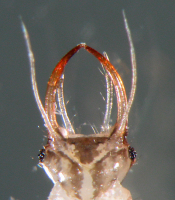
Markings on head capsule
|
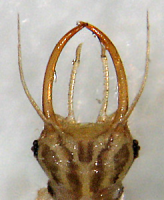
Markings on head capsule
|

Head anteriorly white or pale luteous, with a pair of bright pink markings on sides
|
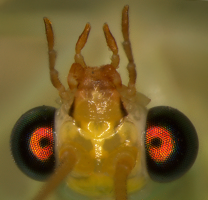
Head anteriorly green, with a pair of pitch brown to black, L-shaped markings on sides
|
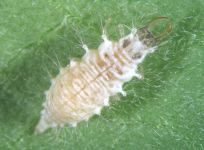
(Larva shown without trash)
|
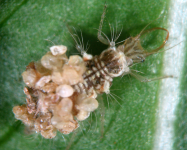
(Larva shown carrying trash)
|
Preservation of chrysopids
Most of the literature on chrysopids from India is unreliable and based on suspect or wrong identifications. It is, hence, essential to preserve the chrysopid species used in a study for
future reference / verification of identity. Identification of chrysopids is best left to an expert because even at the tribal and generic level, the male and / or female genitalia are frequently used for diagnosis. It is nearly impossible even for an expert to determine dry, pinned chrysopid material
correctly. All chrysopid specimens should ideally be collected into and stored in ethyl alcohol for expert identification. Dry material, if preserved, needs to be soaked in water and then transferred to alcohol before identification and it may not be possible to identify such material.
References
- Brooks, S.J. 1997. An overview of the current status of Chrysopidae (Neuroptera)
systematics. Deutsche entomologische Zeitschrift 44: 267-275.
- Brooks, S.J. & Barnard, P.C. 1990. The green lacewings of the world: a generic review (Neuroptera: Chrysopidae). Bulletin of the British Museum (Natural History) Entomology 59: 117-286.
- Canard, M., Semeria, V. & New, T.R. 1984. Biology of Chrysopidae. Dr. W.Junk Publishers, Berlin. 294 p.
- Ghosh, S.K. & Sen, S. 1977. Check-list of Indian Planipennia (Order Neuroptera). Records
of the Zoological Survey of India 73: 277-326.
- McEwen, P.K., New, T.R. & Whittington, A.E. 2001. Lacewings in the crop environment. Cambridge University Press, Cambridge. 546 p.
- Monserrat, V.J., Oswald, J.D., Tauber, C.A., and Diaz-Aranda, L.M. 2001. Recognition of larval Neuroptera, pp. 43-81. In: Lacewings in the crop environment (P.K.McEwen, T.R. New & A.E. Whittington). Cambridge University Press, Cambridge. 546 p.
- New, T.R. 2001. Introduction to the systematics and distribution of Coniopterygidae, Hemerobiidae, and Chrysopidae used in pest management, pp. 6-28. In: Lacewings in the crop environment (P.K.McEwen, T.R. New & A.E. Whittington). Cambridge University Press, Cambridge. 546 p.
- Singh, S.P. & Jalali, S.K. 1991. Chrysopid predators: their production and use.Extension Bulletin No. 2, National Centre for Integrated Pest Management, Bangalore. 12 p.
- Singh, S.P. & Narasimham, A.U. 1994. Indian Chrysopidae. Technical Bulletin No. 5, Biological Control Centre (National Centre for Integrated Pest Management), Bangalore. 34 p.
|